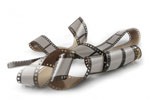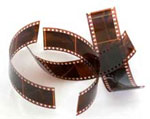Calculator!

Negative or Print film is a strip of transparent plastic based film that is coated on one side with a gelatin emulsion containing microscopically small light-sensitive silver halide crystals. The emulsion is exposed to a very short view of the image producing a very slight chemical change. This creates an invisible latent image in the emulsion which can be chemically developed into a fully visible photograph.

Black and White film uses a layer of silver salts. When the exposed grains are developed, the silver salts are converted to metallic silver, which blocks light and appears as the black part of the film negative. This metallic silver is the reason we cannot use Digital ICE on B&W film.

Color film uses three colored dye layers (Red, Green and Blue). These dyes make the crystals sensitive to different colors. During development, the exposed silver salts are converted to metallic silver, just as with black & white film, but in color film the by-products use chemicals known as color couplers to form colored dyes. Following development the silver is converted back to silver salts and is removed from the film in the final step leaving behind only the formed color dyes, which combine to make up the colored visible image.

The name "126" was intended to show the images were 26mm square, however the image size is actually 28mm square. The film was originally available in 12 and 20 image lengths. It was introduced in 1963 and is generally associated with low-end point and shoot cameras.

110 is a cartridge-based film that was introduced by Kodak in 1972 and is essentially a miniaturised version of Kodak's earlier 126 film format. Most 110 cameras were made cheaply, with mediocre lenses and rudimentary exposure control, because of this, it is difficult to make quality enlargements. We always scan this film format at our highest (4000 DPI) resolution.

